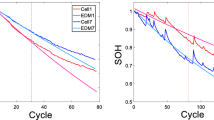Abstract
For characteristics of the wireless sensor network (WSN) nodes data streaming in the application environment, the limitations of conventional principal component analysis (PCA) method which depend on the static model in practical application are discussed, an online fault diagnosis algorithm in WSN nodes based on recursive PCA (RPCA) model and support vector data description (SVDD) for multi-class classification is proposed in this paper. The main contents of the method include:The algorithm first applies recursive eigenvalue decomposition techniques based on first-order perturbation (FOP) analysis to update the PCA model adaptively and realize the online fault detection, and then uses SVDD based multi-class classification algorithm to diagnose the fault types. Experimental results show that the algorithm can satisfy the real time needs of data stream processing, but also can track the data changes well. The experimental results based on data sets in real field and experimental data off our typical node failures demonstrate the effectiveness of the proposed algorithm. The algorithm proposed in this paper would improve the safety factor of monitoring sites and it can allows us to know the working state of the node in time and repair or replace it at first time.












Similar content being viewed by others
References
Fall, K.: Disruption tolerant networking for heterogeneous ad hoc networks. IEEE Mil. Commun. Conf. Atl. 4(1), 2195–2201 (2005)
Chong, C.Y., Kumar, S.P.: Sensor networks: evolution, opportunities, and challenges. Proc. IEEE 91(8), 1247–1256 (2003)
Geng, J.T., Zhou, X.J., Zhang, B.: An atmosphere environment monitor system based on wireless sensor network. J. Xihua Univ. 26(4), 44–46 (2007)
Guangzhao, C., Song, J.: An agricultural environment monitor system based on wireless sensor network. Commun. Technol. 41(12), 287–289 (2008)
Park C., Chou P. H., Bai Y., et al: An ultra-wearable, wireless, low power ECG monitoring system. Biomedical Circuits and Systems Conference, London, pp. 241–244 (2006)
Fei, J., Xia, L.: Design of monitoring system for home environment based on zigBee technology. Comput. Dev. Appl. 21(2), 55–59 (2008)
Jing, X., Wang, W., Hei, L.: Application of wireless sensor networks in coal mine safety intelligent monitoring system. Coal Technol. 28(4), 93–97 (2009)
Wenjie, C., Lifeng, C., Zhanglong, C., et al.: A realtime dynamic traffic control system based on wireless sensor network. In: Proceedings of the 2005 International Conference on Parallel Processing Workshops (ICPPW’05), pp. 258–264 (2005)
Ren, F., Huang, H., Lin, C.: Wireless sensor networks. J. Softw. 14(7), 1282–1291 (2003)
Akyildiz, I.F., Su, W., Sankarasubramaniam, Y.: A survey on sensor networks. IEEE Commun. Mag. 8, 102–114 (2002)
Zheng, J., Qu, Y., Zhao, B.: Embedded self-organized communication protocol stack for wireless sensor networks. J. Beijing Univ. Posts Telecommun. 32, 84–87 (2009)
Li, J.Z., Li, J.B., Shi, S.F.: Concepts, issues and advance of sensor networks and data management of sensor networks. J. Softw. 10, 1717–1725 (2003)
Mahapatro, A., Khilar, P.M.: Online fault diagnosis of wireless sensor networks. Cent. Eur. J. Comput. Sci. 4(1), 30–44 (2014)
Lo, C., Lynch, J.P., Liu, M.: Distributed model-based nonlinear sensor fault diagnosis in wireless sensor networks. Mech. Syst. Signal Process. 66–67, 470–484 (2016)
Chanak, P., Banerjee, I., Sherratt, R.S.: Mobile sink based fault diagnosis scheme for wireless sensor networks. J. Syst. Softw. 119, 45–57 (2016)
Panda, M., Khilar, P.M.: Distributed self fault diagnosis algorithm for large scale wireless sensor networks using modified three sigma edit test. Ad Hoc Netw. 25, 170–184 (2015)
Aydın, I., Karaköse, M., Akın, E.: Combined intelligent methods based on wireless sensor networks for condition monitoring and fault diagnosis. J. Intell. Manuf. 26(4), 717–729 (2015)
Garai, B.C., Das, P.: A novel approach for fault diagnosis in wireless sensor networks. Commun. Netw. 05(2), 169–177 (2013)
Yugeng, S., Jing, Z., Yongjin, S.: Wireless self-organized sensor network. J. Trans. Technol. 17(2), 331–348 (2004)
Wu, M.Y., Dong, H., Xingting, D.: DC/DC power module minimization technology study. Power Electron. 45(9), 76–78 (2011)
Qian, Z.: Research and Application on High Performance Data Flow Pattern Discovery Algorithm. Zhejiang University, Zhejiang (2008)
Wold, S.: Exponentially weighted moving principal component analysis and projection to latent structures. Chemom. Intell. Lab. Syst. 23(1), 149–161 (1994)
Weihua, Li, Yue, H., Valle-Cervantes, S., et al.: Recursive PCA for adaptive process monitoring. Process Control 10, 471–486 (2000)
Martin, E.B., Morris, A.J.: Adaptive multivariate statistical process control for monitoring time-varying processes. Ind. Eng. Chem. Res. 45(9), 3108–3118 (2006)
Champagne, B.: Adaptive eigen decomposition of data covariance matrices based on first-order perturbations. IEEE Trans. Signal Process. 42(10), 2758–2770 (1994)
Peddaneni, H., Erdogmus, D., Rao, Y.N., et al.: Recursive principal components analysis using eigenvector matrix perturbation. Eurasip J. Adv. Signal Process. 13, 2034–2041 (2004)
Wang, X., Kruger, U., Irwin, G.W.: Process monitoring approach using fast moving window PCA. Ind. Eng. Chem. Res. 44(15), 5691–5702 (2005)
Zhisong, M.Z.M.P., Lu-wen, Y.W.W.Z.: New multi-class classification based on support vector date description. Comput. Sci. 36(3), 65–68 (2009)
Du, J.: Study on Theory and Methods of Intelligent Fault Diagnosis Based on Kernel AlgorithmStudy on Theory and Methods of Intelligent Fault Diagnosis Based on Kernel Algorithm. Xi‘an University of Science and Technology, Xi‘an (2006)
Qing, Z., Guanghua, X., Jing, W.: Dynamic multi-fault diagnosis model based on support vector domain description. J. Xi’an Jiaotong Univ. 41(5), 593–597 (2007)
Yu, L.U.O., Wende, Y.I., Dake, H.E., et al.: Fast reduction for large-scale training data set. J. Southwest Jiaotong Univ. 42(7), 468–472 (2007)
Acknowledgements
This work was financially supported by Natural Science Foundation (No. ZR2016FM28) of Shandong Province in 2016. Scientific research in this paper was also supported by China Postdoctoral Science Foundation (No. 20100480208).
Author information
Authors and Affiliations
Corresponding author
Rights and permissions
About this article
Cite this article
Sun, Qy., Sun, Ym., Liu, Xj. et al. Study on fault diagnosis algorithm in WSN nodes based on RPCA model and SVDD for multi-class classification. Cluster Comput 22 (Suppl 3), 6043–6057 (2019). https://doi.org/10.1007/s10586-018-1793-z
Received:
Revised:
Accepted:
Published:
Issue Date:
DOI: https://doi.org/10.1007/s10586-018-1793-z




